Developing Your CPG Ecommerce Strategy: How to Adapt Amid Changes in 2023
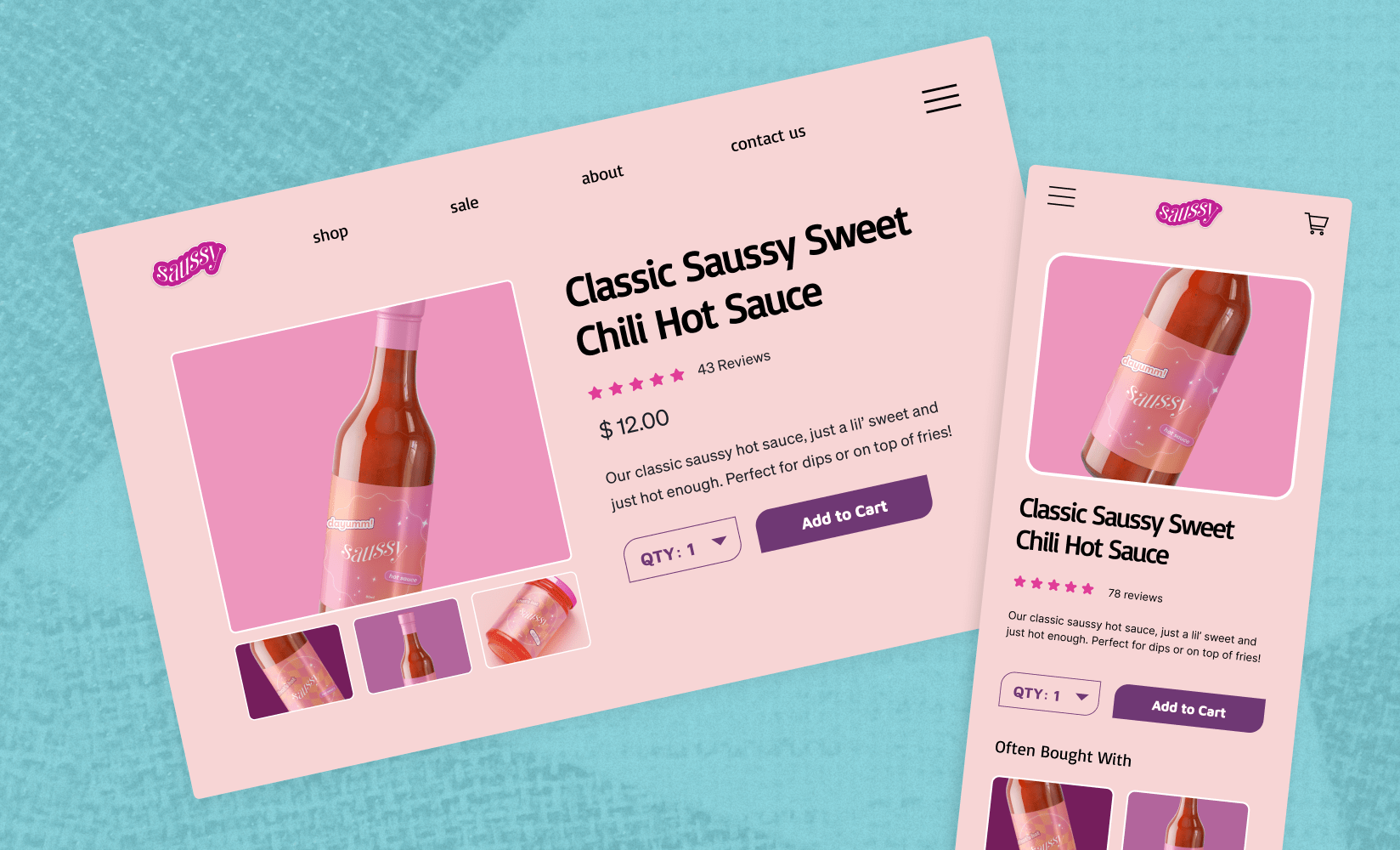
The consumer-packaged goods industry is constantly changing. Combine that with the evolving state of ecommerce, and you’ll see why many CPG operators struggle to stay ahead of the game.
“What got you here won’t get you there” is a motto true in the CPG industry. All facets of CPG ecommerce are changing, from packaging and operations to marketing and retention.
The harsh reality is: falling behind is an expensive mistake to make. The CPG industry is on track to value 25 million by 2030. This valuation is no surprise, with consumers purchasing their favorite CPG every day, week, or month.
So, how do you keep up?
This guide shares concrete tactics CPGs can use to endure the ever-changing industry and current ecommerce climate.
We’ll cover the following:
- The top CPG ecommerce challenges merchants face
- Critical components of a CPG ecommerce strategy
- What makes CPG ecommerce strategies successful today?
- Benchmarks for ecommerce success in CPG today
- How to recession-proof your CPG ecommerce strategy
The top CPG ecommerce challenges merchants face
Even with the best intentions, CPG ecommerce strategies can fall by the wayside due to circumstances outside of your control. Let’s dive deeper into the top CPG ecommerce challenges merchants face this year.
Impending recession
The word “recession” has been on everyone’s lips since the COVID-19 pandemic. But it’s a serious threat. Nielsen reports that CPG inflation is at a record high of 12% compared to last year.
Ciento CBD is one brand that has faced recession challenges head-on. Its owner Charles Wagner says the CPG company saw a drop in sales between December 2022 and January 2023.
“To pinpoint why this is the case is somewhat difficult,” says Wagner. “However, we open dialogues with our customers to enhance our understanding of the market. Doing so has allowed us to conclude that people are spending less money and saving instead.”
Charles adds, “We expect people will begin loosening their belts around March, having saved up some money in January and February. Sales will be quite volatile in 2023. As certainty starts creeping back into the economy, this should improve. We’re expecting a better 2024.”
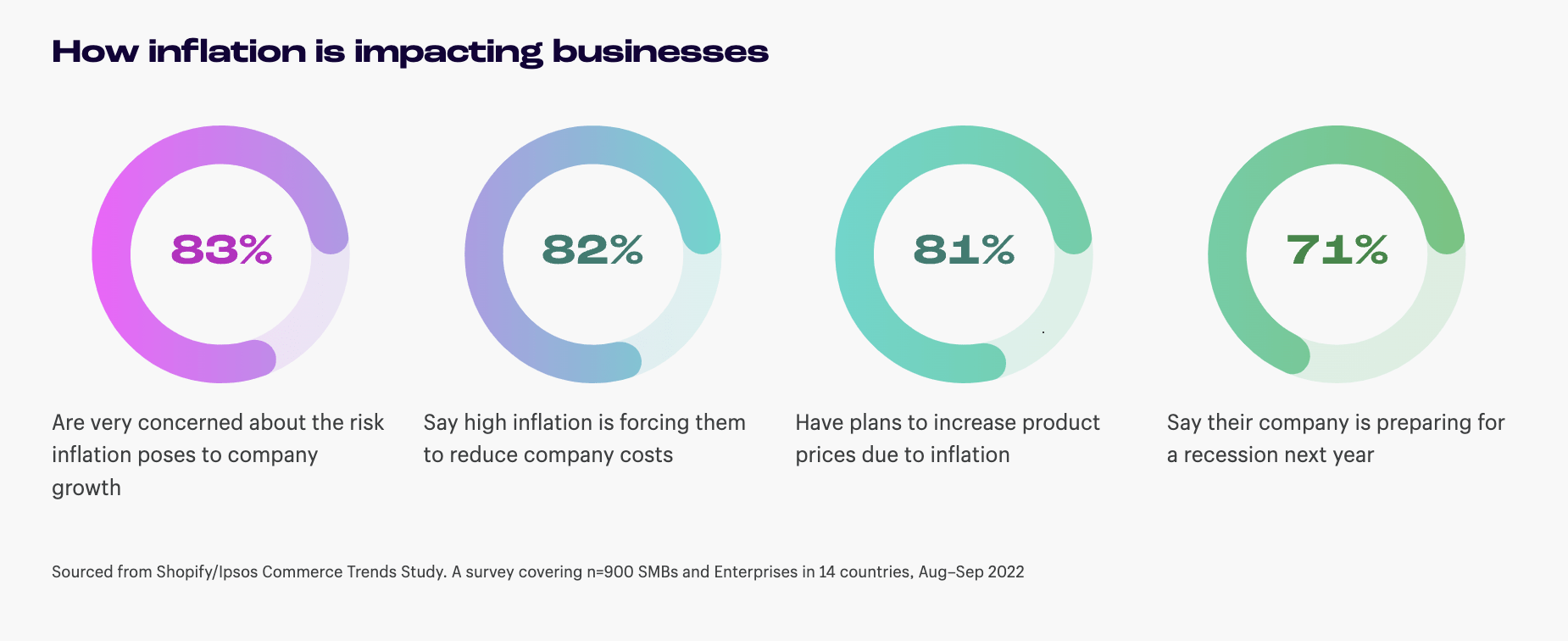
Increasing costs
Recession-induced inflation and an unstable economic climate are causing everything to get more expensive:
- Wholesale costs for the CPG industry have risen by 35% since 2019
- The cost per click (CPC) of Google paid search ads has risen in beauty, home and garden, apparel, and consumer electronics industries year over year
- The average cost of a shipping container is four times higher than a year ago
- The price of essential packaging materials, such as paper, corrugated cardboard, and plastic, is increasing
- Marketplaces like Amazon have introduced an additional holiday peak fulfillment fee for brands using its fulfillment services
To top things off, venture capital is drying up. CPG brands need to meet (or sustain) excessive growth targets with fewer resources. It’s why many CPG operators are contributing to the “shrinkflation” epidemic, where customers get the same amount of product for a much higher price.
It gets worse: these rising costs hinder acquisition and loyalty. Research shows that over 60% of consumers have seen stockout notifications, just over one in 10 have waited for the item to become available again, and most customers complete their purchase with another brand.
“Global supply chains and operational complexities are the biggest challenges for brands continuing to grow. For brands on the decline, the increasing cost to acquire customers and shrinking funding options are causing significant pain.”— Paul Jauregui, co-founder of BK Beauty
Talent retention
Legacy CPG brands like PepsiCo have announced plans to lay off their team in 2023 “to simplify the organization so we can operate more efficiently.”
Talent retention is an issue plaguing many CPG online retailers. One study by Glossy and Modern Retail found more than half of retailers are concerned about finding enough warehouse, fulfillment, and customer service staff.
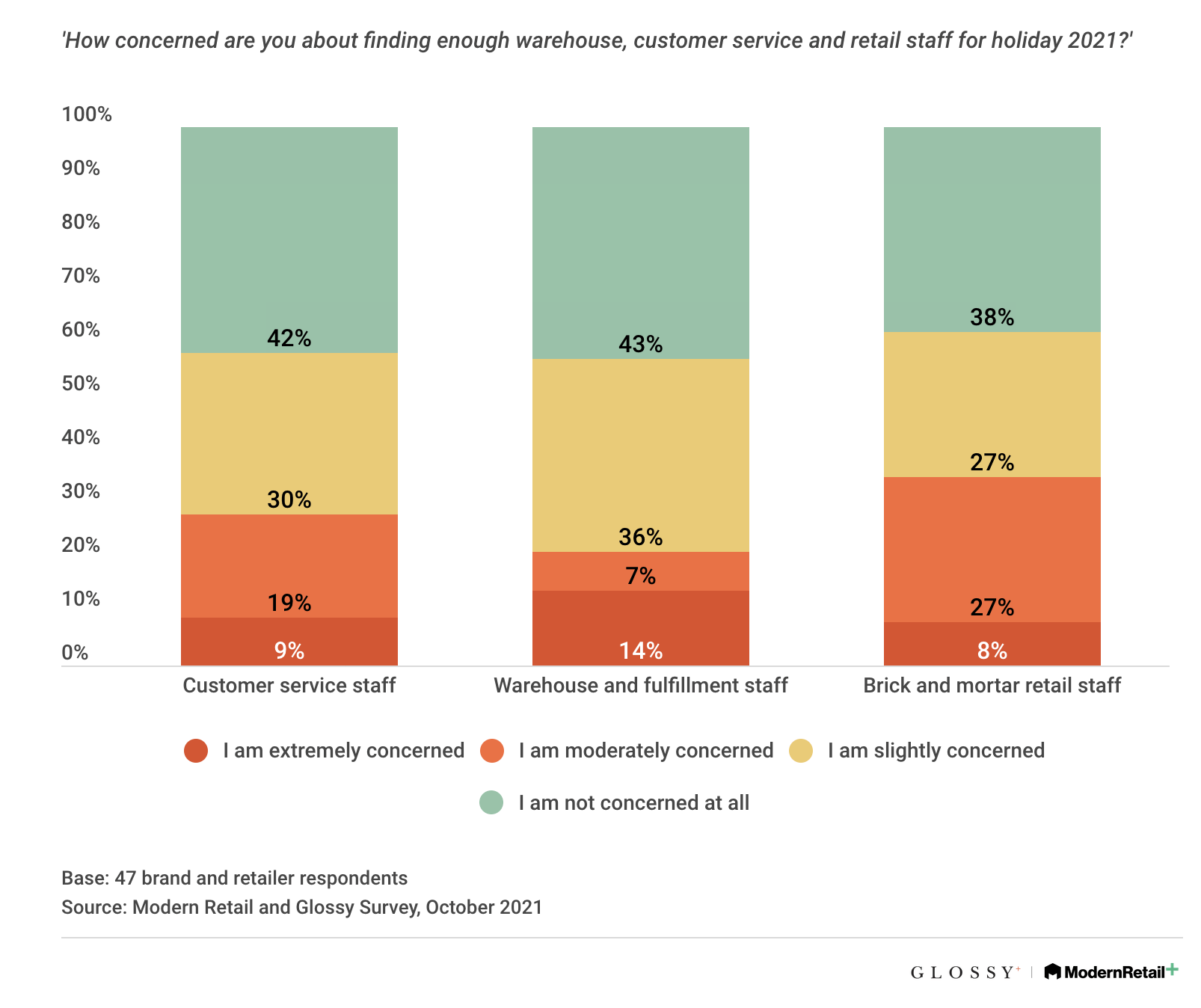
As Jai Dolwani, CMO at Winc, explains, “The economics of ecommerce businesses shifted temporarily in 2020 as a pandemic response, and companies quickly grew their fixed costs (primarily personnel) as a result. As demand has normalized and acquisition marketing is more difficult and expensive, brands are left with large teams and moving toward layoffs.”
As a result, Jai predicts “2023 will be a year of cutting down SaaS spend, right-sizing teams, and moving to flexible, talent-based models such as freelancing or contractors.”
Competition against talent-led brands
The past decade has paved the way for creators, celebrities, and influencers to launch their businesses. They’re moving beyond branded merchandise and monetizing loyal fan bases with CPG brands.
Data from FABID found celebrity-backed CPG brands, such as:
- Kendall Jenner’s 818 Tequila
- Logan Paul and KSI’s Prime Hydration
- Emma Chamberlain’s Chamberlain Coffee
- Katy Perry’s De Soi
…amassed millions in funding. Combine that cash flow with millions of die-hard fans, and it paints a bleak picture for emerging CPG brands without celebrity backing.
“Influencers will try to follow in Mr. Beast and Logan Paul/KSI’s successes with their own food and beverage brands.” — Filip Pejic, founder of Pearly
However, Dhruv Patel, founder of Celebrity Packaged Goods, says, “Modern CPG brands don’t need to be thinking about how to compete versus celebrity/influencer brands. They need to think about how to acquire and retain customers through a flawless customer experience strategy.”
#cta-visual-pb#<cta-title>Build landing pages at the speed of CPG ecommerce changes<cta-title>Create and customize landing pages with all the vital elements for conversions.Start designing today
Components of a CPG ecommerce strategy
The process of selling CPG online is more convoluted than other products. Items often have short shelf lives, low prices, and retention baked in.
The most critical components of a CPG ecommerce strategy include the following:
- Supply chain management. How will you source products and deliver them to your customers? Clarify your raw material sourcing, how to manufacture CPGs, and whether you’ll work with a third-party logistics (3PL) provider or handle fulfillment in-house.
- Packaging. An attractive design isn’t always the most critical aspect of product packaging. With short shelf lives, your CPG ecommerce strategy needs to factor in product packaging and storage. Otherwise, you run the risk of dead stock.
- CPG marketing strategy. It’s getting increasingly expensive to acquire new customers. From social media to search engine optimization (SEO), discover how customers find new CPG products—and double down on it.
- Pricing strategy. CPG is low priced, often forcing brands to sell large volumes to turn a profit through their direct-to-consumer (DTC) storefront. Consider how your ecommerce pricing balances across alternative online sales channels. For example, marketplaces often take a fee for any sales; retail partners expect wholesale pricing. Both eat into profits.
- Loyalty and retention. Just 8% of consumers consider brand names when evaluating new CPG purchases. Have a strategy in place to convince first-time customers to make repeat purchases. These customers are more likely to share your brand with family and friends.
What makes CPG ecommerce strategies successful today?
Unfortunately, not all ecommerce strategies turn CPG brands into multi-million dollar companies.
According to Eric Bandholz, founder of Beardbrand, an effective CPG ecommerce strategy includes “being able to profitably find your niche audience and deliver a product that enhances their lives.
“It takes trial and error to find the right channels, whether paid social acquisition or an organic content strategy. There is no one right way to build a business.”
Oren Schauble of Valuable Studios believes that successful CPG ecommerce strategies are collaborative. He says, “How can your brand work with your channel partners, other complementary brands in similar categories, and creators to establish a narrative to consumers?
“It goes beyond just web pages, product detail pages, and advertisements. It becomes: what is the conversation around your brand happening daily online?”
Benchmarks for ecommerce success in CPG today
Comparing your ecommerce data against other CPG brands allows you to understand your data better. Here are four of the main CPG ecommerce metrics to determine success:
- The largest CPG companies boast operating margins between 14.7% and 21.9%.
- The average conversion rate for ecommerce is 2.1%, though some CPG verticals exceed this benchmark. Health and beauty, haircare, and food and beverage companies all boast 3%+ conversion rates.
- For brands in the CPG food and beverage industry, abandoned cart emails are the most effective type of campaign. They have a click-through rate of 7.34%, a conversion rate of 4.03%, and an average $2.60 in revenue per recipient.
- The average SMS form conversion rate is 3.15% for food and beverage brands, with a 0.23% customer conversion rate and an 8.22% click rate.
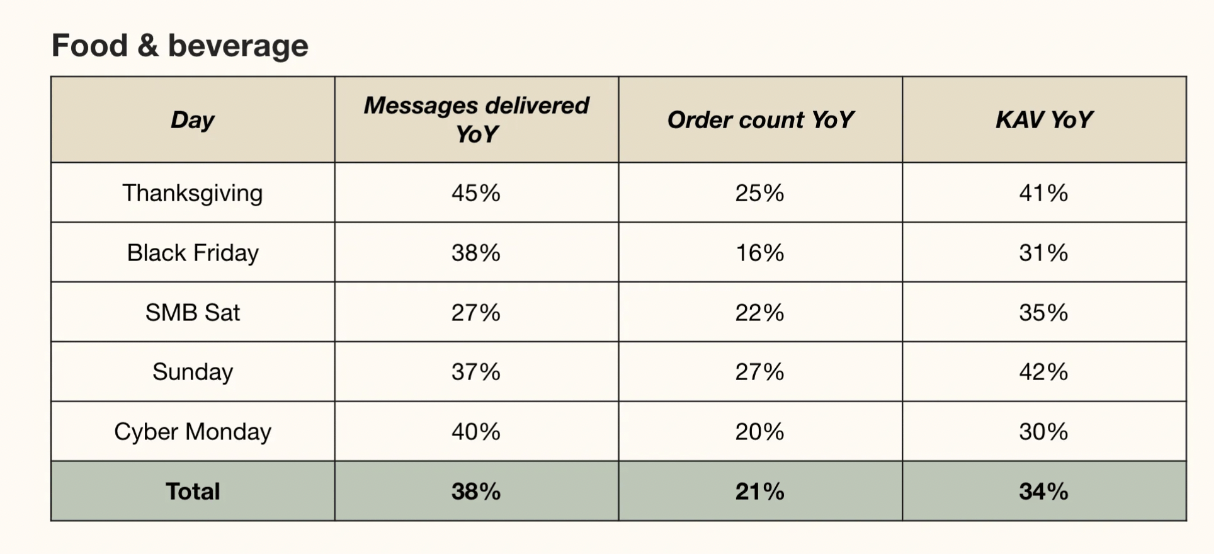
#cta-visual-pb#<cta-title>Create a high-impact ecommerce site for your CPG ecommerce brand<cta-title>Make your store look and feel as unique as your brand by customizing with the best page builder.Start building for free
5 things to recession-proof your CPG ecommerce strategy
A looming recession can instill fear in any CPG operator’s boots. Let’s look at specific things you should be doing to make it through, with examples from CPG brands doing it successfully.
1. Minimize non-essential expenses
The cost of doing business is rising. Audit recurring expenses to remove non-essential subscriptions and barter with suppliers you’ve built strong relationships. Even the smallest discount can result in healthier profit margins.
Pearly is one beverage CPG brand mitigating inflation by minimizing non-essential expenses. Founder Filip Pejic says this move is to “ensure we can continue to grow profitably and employ our team.”
According to Filip, Pearly’s strategy includes:
- “Auditing our software stack pricing and working with vendors to get temporary discounts for the recession
- Working with suppliers to find savings in our supply chain while maintaining quality
- Minimizing expensive low ROI marketing campaigns while doubling down on profitable areas of our marketing portfolio”
“By focusing on these big pillars, we can ensure we’re not over-spending in any of the major parts of our business and doing our best to set ourselves up for growth in a recessionary environment,” Filip says.
“Beyond fulfillment, there is an opportunity to scale operations by leveraging third-party suppliers for packaging, assembly, and other operational needs. This may be different for each brand, but at scale, it allows brands to spend less time managing operations in-house and potentially save on costs.”— Filip Pejic, founder of Pearly
2. Prioritize community commerce
CPG operators who build a loyal community build a protective moat around their brand. Community helps shield against reducing consumer spend and rising costs.
“Last decade’s ecommerce playbook involved buying customers on Facebook with other people’s money,” says Paul Jauregui, co-founder of BK Beauty. “Those days are over.
“This decade’s winning strategy is “audience-first,” where brands earn customers with content and community. In today’s connected world, content builds community, and community fuels commerce.”
The beauty brand produces TikTok and Instagram content that shows the behind-the-scenes of building the business. Followers leave comments to celebrate the brand’s small—yet impactful—wins: thanking them for the handwritten note in their order and praising their small but mighty team.

Paul continues, “Content creators with loyal audiences will unlock their full market potential by launching or partnering with consumer product brands. “Audience-first” strategies have breached the “large sums of capital” moat. Your audience, authenticity, and focused product release are the new fuel.”
3. Explore strategic financing
Venture capital is drying up. Interest rates have doubled in two years. Due to weaker economic sentiment, more than a quarter of businesses expect raising money to be more difficult this year.
CPG companies have to remain competitive with fewer resources.
In an interview, Ignacio Semerene, co-founder of Bags, said, “Brands that want to survive and thrive over the next year and beyond need to focus on establishing an authentic brand and community, growing revenue to cash flow positivity, and avoiding the pitfalls of expensive credit card debt through strategic financing that they’re planning for now.”
If you’re one of the 73% of brands that plan to rely on external investors in 2023, explore strategic financing options, such as:
- Merchant cash advances
- Lending from friends and family
- Government funding or grants
- Revenue-based loans from providers like Shopify Capital
“I see a lot more competition, with a potential for excess inventory for many companies, which will result in a drop in prices for consumers. Companies unable to unload their inventory will go out of business. As the economy returns, those who’ve managed their P&Ls will thrive.” — Eric Bandholz, founder of Beardbrand
4. Offer omnichannel experiences
Modern-day consumers expect the ability to purchase anywhere, from any brand, a la the digital shelf. If your product isn’t accessible, there’s a strong possibility they’ll buy from a competitor who is.
Expand your CPG ecommerce plans with an omnichannel strategy. Give customers seamless shopping experiences regardless of the device, location, or channel.
This doesn’t just mean online shopping via social commerce or marketplace selling.
Studies show that more than one in five shoppers combine an in-store shopping trip with an online order pickup. In other words, operating more than three channels can increase your order rate by 494%.
Alternative offline sales channels to operate alongside your DTC ecommerce strategy include:
- Owned physical brick-and-mortar stores
- Temporary pop-up shops or pop-in stores
- Wholesale partnerships with big-box retailers like Target or Walmart
“Almost all of the successful brands we know today are getting creative with their go-to-market approach,” says Dhruv Patel, founder of Celebrity Packaged Goods. “They are asking questions like, “My customers make purchasing decisions in more places than online. Where are these customers located, and how do we activate our brands in places that make sense?”
“Out-of-home has been the biggest winner in all of this. Brands who want to be successful need to learn how to activate themselves past online channels.”
“In 2023 especially, ecommerce is no longer the sole focus. It works with new in-person experiences like pop-ups, curated experiences, and collaborative retail with multiple brands. Successful CPG brands embrace omnichannel and use ecommerce as a tool to support experience both online and in real life.” — Oren Schauble of Valuable Studios
5. Increase the perceived value of your products
Consumer shopping habits are changing. In one Nielsen study, 31% of consumers said they would buy whatever was on promotion. Over a quarter have stopped shopping specific categories altogether, suggesting online shoppers are buying less and are more aware of waste.
“Young brands are more likely to sell a product that a shopper could live without; a nice to have vs. a need to have,” said Amy Zitelman, founder of Soom, in an interview with Modern Retail. “So the ratio of value-to-product is susceptible to increased price consciousness during an inflation or potential recession.”
Perceived value describes the desirability of a product. The likelihood of CPG meeting expectations, plus the opinions of others, influences how much value customers place on an item.
The more valued it is, the more likely customers will pay higher prices.
“People are less likely to spend money. If they are going to spend money on your product, they must be certain it will work for them.” — Charles Wagner, owner of Ciento CBD
Smart ways to increase the perceived value of your CPG products include:
- Heavily leaning on social proof, such as expert or influencer endorsements, in omnichannel marketing campaigns
- Increasing the price. While it might sound counterintuitive, psychology studies show people perceived expensive wine to taste better than cheaper bottles (even though it was the same).
- Communicating the benefits of purchasing a product (such as health benefits, which tap into the health and wellness industry—set to be worth $1 trillion by 2026)
OLIPOP, for example, communicates the health benefits of its products across its online store, product packaging, and digital marketing campaigns. Ingredients callouts like these signal to shoppers why this product is worth more than standard beverages.
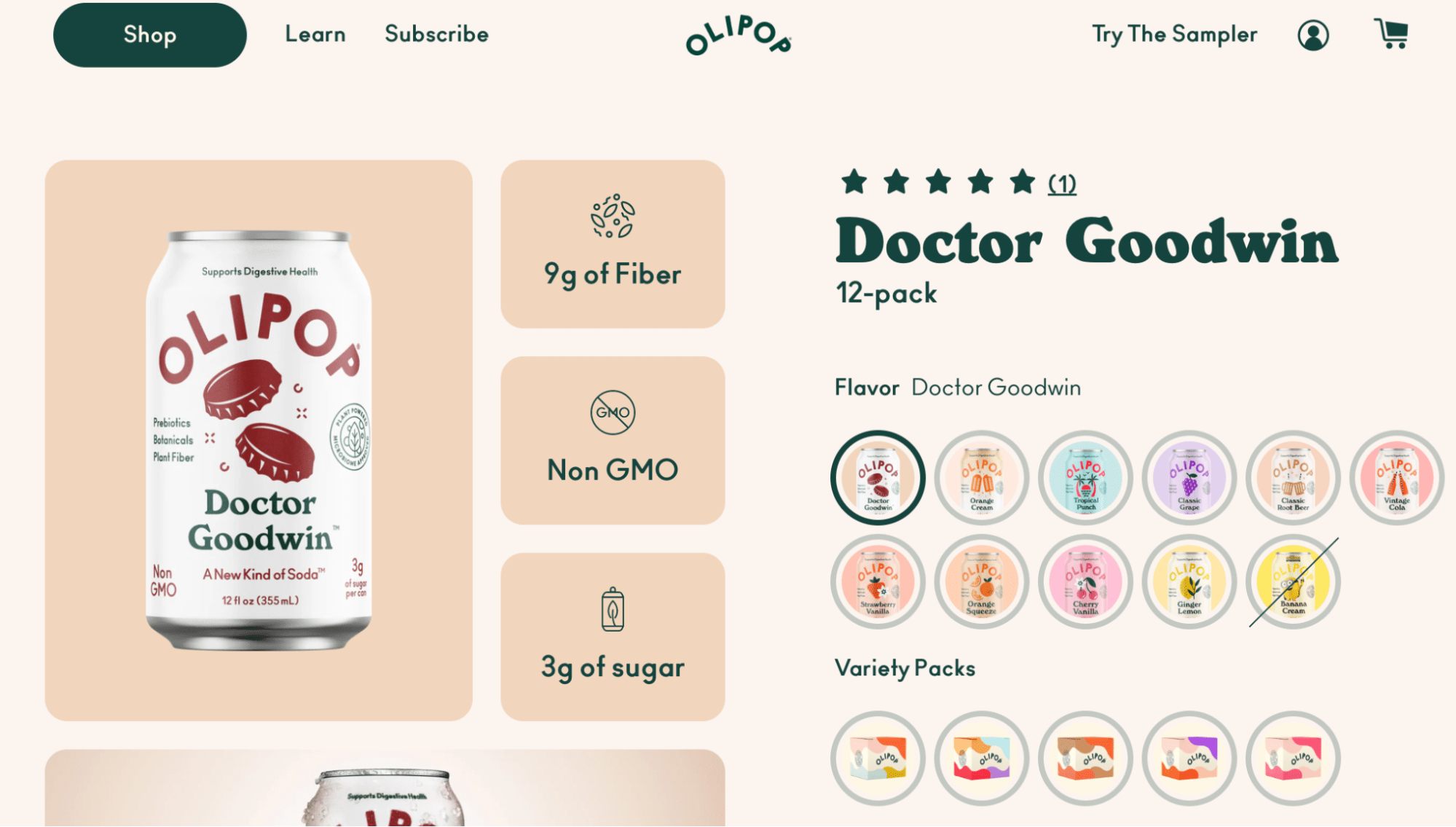
Survive and thrive with your CPG ecommerce strategy
One thing’s for sure: 2023 will be a challenging year for CPG brands.
The impending recession, rising costs, and competing with talented brands mean that current strategies may soon become obsolete.
The good news is that you can get ahead. Explore strategic financing if you’re facing strapped resources. Increase the perceived value of your products to convince customers to keep spending, and offer omnichannel experiences that make it easy to shop wherever, whenever.
#cta-visual-pb#<cta-title>Create a high-impact ecommerce site for your CPG ecommerce brand<cta-title>Make your store look and feel as unique as your brand by customizing with Shogun Page Builder.Start building for free

Elise Dopson
Elise Dopson is a freelance writer for B2B commerce and martech companies. When she's not writing, you'll find her in the Peak Freelance community or on Twitter.



